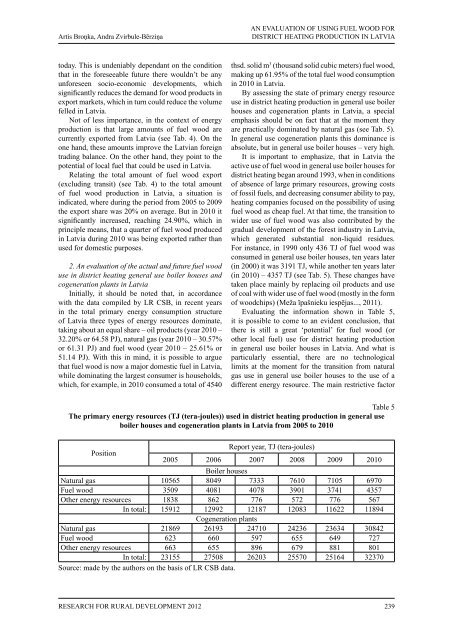RESEARCH FOR
RESEARCH FOR
RESEARCH FOR
Create successful ePaper yourself
Turn your PDF publications into a flip-book with our unique Google optimized e-Paper software.
Artis Broņka, Andra Zvirbule-Bērziņa<br />
today. This is undeniably dependant on the condition<br />
that in the foreseeable future there wouldn’t be any<br />
unforeseen socio-economic developments, which<br />
significantly reduces the demand for wood products in<br />
export markets, which in turn could reduce the volume<br />
felled in Latvia.<br />
Not of less importance, in the context of energy<br />
production is that large amounts of fuel wood are<br />
currently exported from Latvia (see Tab. 4). On the<br />
one hand, these amounts improve the Latvian foreign<br />
trading balance. On the other hand, they point to the<br />
potential of local fuel that could be used in Latvia.<br />
Relating the total amount of fuel wood export<br />
(excluding transit) (see Tab. 4) to the total amount<br />
of fuel wood production in Latvia, a situation is<br />
indicated, where during the period from 2005 to 2009<br />
the export share was 20% on average. But in 2010 it<br />
significantly increased, reaching 24.90%, which in<br />
principle means, that a quarter of fuel wood produced<br />
in Latvia during 2010 was being exported rather than<br />
used for domestic purposes.<br />
2. An evaluation of the actual and future fuel wood<br />
use in district heating general use boiler houses and<br />
cogeneration plants in Latvia<br />
Initially, it should be noted that, in accordance<br />
with the data compiled by LR CSB, in recent years<br />
in the total primary energy consumption structure<br />
of Latvia three types of energy resources dominate,<br />
taking about an equal share – oil products (year 2010 –<br />
32.20% or 64.58 PJ), natural gas (year 2010 – 30.57%<br />
or 61.31 PJ) and fuel wood (year 2010 – 25.61% or<br />
51.14 PJ). With this in mind, it is possible to argue<br />
that fuel wood is now a major domestic fuel in Latvia,<br />
while dominating the largest consumer is households,<br />
which, for example, in 2010 consumed a total of 4540<br />
ReseaRch foR RuRal Development 2012<br />
AN EVALUATION OF USING FUEL WOOD <strong>FOR</strong><br />
DISTRICT HEATING PRODUCTION IN LATVIA<br />
thsd. solid m 3 (thousand solid cubic meters) fuel wood,<br />
making up 61.95% of the total fuel wood consumption<br />
in 2010 in Latvia.<br />
By assessing the state of primary energy resource<br />
use in district heating production in general use boiler<br />
houses and cogeneration plants in Latvia, a special<br />
emphasis should be on fact that at the moment they<br />
are practically dominated by natural gas (see Tab. 5).<br />
In general use cogeneration plants this dominance is<br />
absolute, but in general use boiler houses – very high.<br />
It is important to emphasize, that in Latvia the<br />
active use of fuel wood in general use boiler houses for<br />
district heating began around 1993, when in conditions<br />
of absence of large primary resources, growing costs<br />
of fossil fuels, and decreasing consumer ability to pay,<br />
heating companies focused on the possibility of using<br />
fuel wood as cheap fuel. At that time, the transition to<br />
wider use of fuel wood was also contributed by the<br />
gradual development of the forest industry in Latvia,<br />
which generated substantial non-liquid residues.<br />
For instance, in 1990 only 436 TJ of fuel wood was<br />
consumed in general use boiler houses, ten years later<br />
(in 2000) it was 3191 TJ, while another ten years later<br />
(in 2010) – 4357 TJ (see Tab. 5). These changes have<br />
taken place mainly by replacing oil products and use<br />
of coal with wider use of fuel wood (mostly in the form<br />
of woodchips) (Meža īpašnieku iespējas..., 2011).<br />
Evaluating the information shown in Table 5,<br />
it is possible to come to an evident conclusion, that<br />
there is still a great ‘potential’ for fuel wood (or<br />
other local fuel) use for district heating production<br />
in general use boiler houses in Latvia. And what is<br />
particularly essential, there are no technological<br />
limits at the moment for the transition from natural<br />
gas use in general use boiler houses to the use of a<br />
different energy resource. The main restrictive factor<br />
Table 5<br />
the primary energy resources (tJ (tera-joules)) used in district heating production in general use<br />
boiler houses and cogeneration plants in Latvia from 2005 to 2010<br />
Position<br />
2005 2006<br />
Report year, TJ (tera-joules)<br />
2007 2008 2009 2010<br />
Natural gas 10565<br />
Boiler houses<br />
8049 7333 7610 7105 6970<br />
Fuel wood 3509 4081 4078 3901 3741 4357<br />
Other energy resources 1838 862 776 572 776 567<br />
In total: 15912 12992 12187 12083 11622 11894<br />
Cogeneration plants<br />
Natural gas 21869 26193 24710 24236 23634 30842<br />
Fuel wood 623 660 597 655 649 727<br />
Other energy resources 663 655 896 679 881 801<br />
In total: 23155 27508 26203 25570 25164 32370<br />
Source: made by the authors on the basis of LR CSB data.<br />
239


